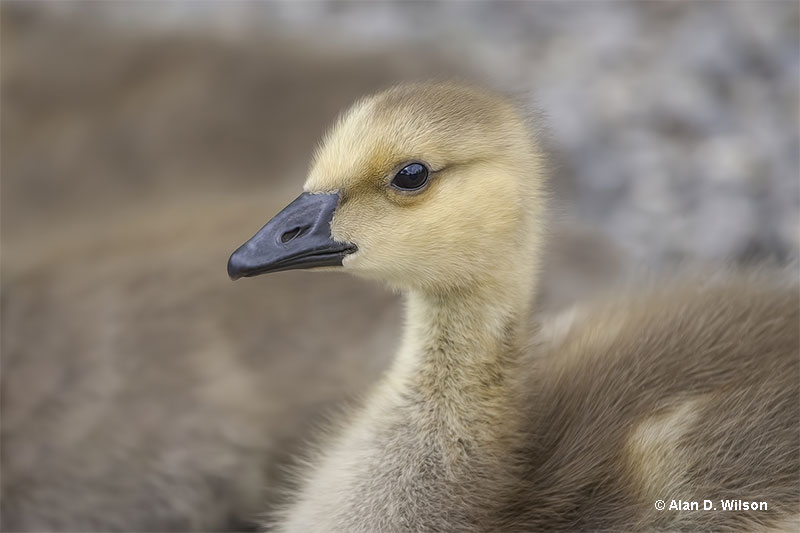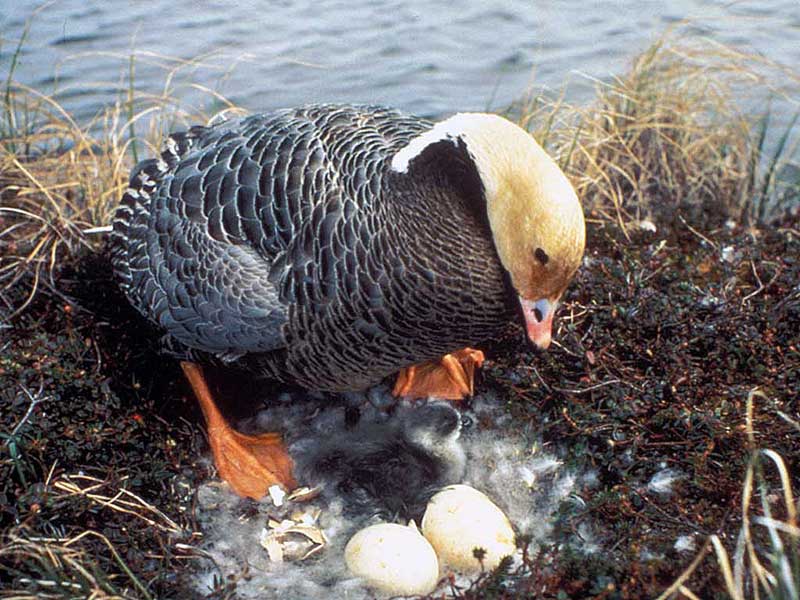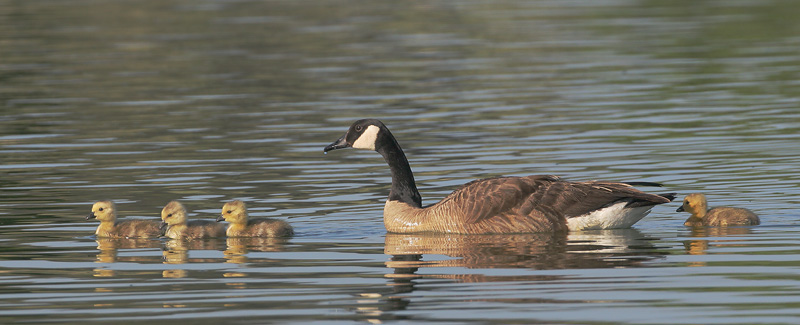
Baby geese are called goslings. At this age, these birds are unable to fly and are usually still covered with fluffy, soft down feathers.
A baby goose hatches with the ability to feed themselves and move independently almost immediately. They walk and swim well and can efficiently forage on their own. Yet despite their independence, goslings will stay with the family flock with their parents for many weeks or months as they mature.
Baby geese are similar to cygnets and ducklings but are special in many ways too. Keep reading to learn more about goslings!
On this page
Nest
Geese build their nests on the ground, usually on slightly elevated sites like a muskrat mound near water. These birds prefer spots that give them a relatively unobstructed view in all directions.
Read more: Do geese mate for life?
Female geese pick the nesting area and do most of the nest construction. After the second egg is laid, she’ll add some body and down feathers to the nest.
She does all of the incubating while the male guards her and the nest.

The nest is a big open cup on the ground. It consists of lichens, dry grasses, mosses, and other plant material. They’re lined with some body and down feathers.
- The clutch size is 2 to 8 eggs.
- Geese have 1 brood per breeding season.
- Egg length can be anywhere from 3.3 inches (8.3 centimeters).
- Egg width can be anywhere from 2.2 inches (5.6 centimeters).
- The incubation period is 25 to 28 days.
- The nestling period is 42 to 50 days.
- Eggs are creamy white and don’t have any markings.
What Does A Baby Goose Look Like?

Canada Goose family
Baby geese are a lot lighter than ducklings. They also lack the black stripe through the eye and have less defined coloration overall. As a result, goslings are yellower than cygnets, which are light grey.
Learn more: Geese vs Ducks
Additionally, Goslings are larger and have triangular bills and long necks. With their stubby wings and fluffy down, goslings are full of character and cute.
How To Tell Baby Geese Apart?
It can be hard to identify young waterfowl because these birds are purposefully camouflaged for their protection while they mature.
However, goslings can be pretty easily differentiated from ducklings because of their long necks, triangular bill shape, and larger size. On the other hand, ducklings have spatulate-shaped, flattened bills, shorter necks, and are significantly smaller.
Determining the species of a gosling is usually pretty easy to determine. This is because goslings never stray too far from their parents and are almost never seen in mixed flocks.
Related: How long do geese live?
So when trying to determine a goslings species, we recommend looking at its parents. This is one of the best clues to proper identification. Other clues you can use to identify goslings include:
- Range: Young goslings will only leave the breeding range once they have developed their adult plumage. A hard-to-identify and camouflaged gosling will not be seen very far from its mature breeding range.
- Markings: Despite their camouflaged, down plumage, goslings usually have distinguishing markings. This is especially true around the face and head. Noting down the color of the feet and legs and the color of the plumage can help you identify young goslings.
- Voice: Goslings are usually more vocal than adults. Additionally, they have different, distinct begging calls.
What Does A Baby Goose Eat?
Baby geese eat the same things that adult geese do. Gosling will consume a wide variety of roots, grasses, grains, berries, bulbs, and aquatic plants.
These birds are mainly herbivorous, but some species will also consume gastropods, small invertebrates, small fish, and crustaceans. However, for the most part, baby geese consume only grasses and other vegetation.
Related: What do baby birds eat?
Goslings can feed themselves just 24 hours after hatching. After that, they’ll follow their parents to learn what they can and can’t eat.
Frequently Asked Questions
What do you call a baby goose?
Baby geese are called goslings. At this age, these birds are unable to fly and are usually still covered with fluffy, soft down feathers. Goslings hatch with the ability to feed themselves and move independently almost immediately. They walk and swim well and can easily forage on their own.
How long do baby geese stay with their mom and dad?
Baby geese remain with their mom and dad for about a year. In the summer and early fall, goslings will stay close to their parents, that sometimes merges with other family units. In late fall, young geese will join their parents for their first migratory journey. They’ll return in the spring and form juvenile flocks while staying close to their parents. Young geese won’t become fully independent until they reach sexual maturity, which takes at least 2 years.
Where do geese sleep with their babies?
Geese are diurnal. This means that they’re awake during the day. Most geese sleep at night; however, if a goose feels safe, you may be able to catch them napping during the day. It’s common to see flocks of geese near calm human-made lakes and rivers napping during the day since they know no predators around. Goslings usually sleep in the nest with their mother. They’ll most likely sleep next to their mother until they become independent.
How old are baby geese before they fly?
Goslings start flying when they reach 10 weeks of age. They learn how to fly by following their parents around and copying their movements.
What time of year do geese have babies?
Geese lay their eggs in the spring, in the months of March, April, and May. It takes eggs 25 to 30 days to hatch.
What is the survival rate of baby geese?
In their first year, goslings have a slightly higher survival rate. They have a 50% – 70% chance of survival.
Read next: What to do if you find a baby bird

